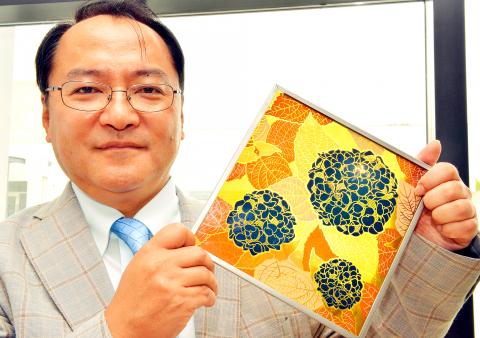A solar cell that resembles a flower offers a new take on “green” energy in Japan, where one scientist is searching for renewables that look good.
In a country badly scarred by the earthquake and tsunami-sparked disaster at the Fukushima Dai-ichi nuclear power plant three years ago, the hydrangea-inspired solar offering might seem insignificant alongside one of the world’s biggest offshore wind power farms now off Japan’s east coast, but Hiroshi Segawa, a professor at the University of Tokyo’s Research Center for Advanced Science and Technology, is hoping his dye-sensitized solar cell, which meshes floral beauty with cutting-edge technology, will brighten the scene.
Segawa’s Annabelle, named after a type of white hydrangea, is made up of flowery stained glass-like solar cells built into a latticed wood box modeled on traditional Japanese doors.

Photo: AFP
While the 20cm-wide box might make a pretty addition to a sunroom, it can also store enough energy to charge your smartphone twice. The leaves generate electricity that is then stored in the flower. As the device charges, the petals turn increasingly blue. However, as Annabelle discharges, those blue petals turn white, just like a real-life hydrangea.
“People do not have a very good image about things related to energy, such as nuclear power,” Segawa told reporters. “Thermal power generation conjures up images of blistering hot dirty coal, while solar panels take up a lot of space. Even wind power generation has problems with bird strikes and noise, but [Annabelle] does not harm the environment.”
While Segawa is not expecting to topple the dominant silicon-based solar panels, he is hoping the fast-growing sector has room for “enjoyable energy” that adds a splash of color to an otherwise drab industry.
Since the disaster in 2011, Japan has been pushing to boost the use of alternative sources of energy.
The country’s solar power generation is rapidly growing, but it still only represents a small share of the overall power mix.
In Japan, the share of power generated from renewable sources, excluding hydropower, lags behind other developed economies at 4.7 percent of the total, far less than 10.4 percent in Britain or the 20.1 percent in Germany, according to data from the International Energy Agency.
Japan’s nuclear plants were shuttered after the 2011 atomic accident — yanking away a power source that once supplied more than one-quarter of the nation’s energy.
Despite Tokyo’s efforts to develop the solar sector, the weather — particularly a lack of reliable sunlight — is among the factors holding back wider use. However, Segawa says Annabelle works even in weak indoor light. It also has a myriad of design possibilities. Segawa has already experimented with a cell that looks like French President Francois Hollande and one resembling the computer-generated Japanese pop star Hatsune Miku.
“You can make solar cells out of animated characters, portraits of real people and lots of other stuff,” he said.

MULTIFACETED: A task force has analyzed possible scenarios and created responses to assist domestic industries in dealing with US tariffs, the economics minister said The Executive Yuan is tomorrow to announce countermeasures to US President Donald Trump’s planned reciprocal tariffs, although the details of the plan would not be made public until Monday next week, Minister of Economic Affairs J.W. Kuo (郭智輝) said yesterday. The Cabinet established an economic and trade task force in November last year to deal with US trade and tariff related issues, Kuo told reporters outside the legislature in Taipei. The task force has been analyzing and evaluating all kinds of scenarios to identify suitable responses and determine how best to assist domestic industries in managing the effects of Trump’s tariffs, he

TIGHT-LIPPED: UMC said it had no merger plans at the moment, after Nikkei Asia reported that the firm and GlobalFoundries were considering restarting merger talks United Microelectronics Corp (UMC, 聯電), the world’s No. 4 contract chipmaker, yesterday launched a new US$5 billion 12-inch chip factory in Singapore as part of its latest effort to diversify its manufacturing footprint amid growing geopolitical risks. The new factory, adjacent to UMC’s existing Singapore fab in the Pasir Res Wafer Fab Park, is scheduled to enter volume production next year, utilizing mature 22-nanometer and 28-nanometer process technologies, UMC said in a statement. The company plans to invest US$5 billion during the first phase of the new fab, which would have an installed capacity of 30,000 12-inch wafers per month, it said. The

Taiwan’s official purchasing managers’ index (PMI) last month rose 0.2 percentage points to 54.2, in a second consecutive month of expansion, thanks to front-loading demand intended to avoid potential US tariff hikes, the Chung-Hua Institution for Economic Research (CIER, 中華經濟研究院) said yesterday. While short-term demand appeared robust, uncertainties rose due to US President Donald Trump’s unpredictable trade policy, CIER president Lien Hsien-ming (連賢明) told a news conference in Taipei. Taiwan’s economy this year would be characterized by high-level fluctuations and the volatility would be wilder than most expect, Lien said Demand for electronics, particularly semiconductors, continues to benefit from US technology giants’ effort

‘SWASTICAR’: Tesla CEO Elon Musk’s close association with Donald Trump has prompted opponents to brand him a ‘Nazi’ and resulted in a dramatic drop in sales Demonstrators descended on Tesla Inc dealerships across the US, and in Europe and Canada on Saturday to protest company chief Elon Musk, who has amassed extraordinary power as a top adviser to US President Donald Trump. Waving signs with messages such as “Musk is stealing our money” and “Reclaim our country,” the protests largely took place peacefully following fiery episodes of vandalism on Tesla vehicles, dealerships and other facilities in recent weeks that US officials have denounced as terrorism. Hundreds rallied on Saturday outside the Tesla dealership in Manhattan. Some blasted Musk, the world’s richest man, while others demanded the shuttering of his